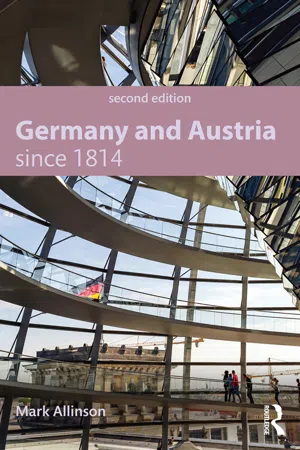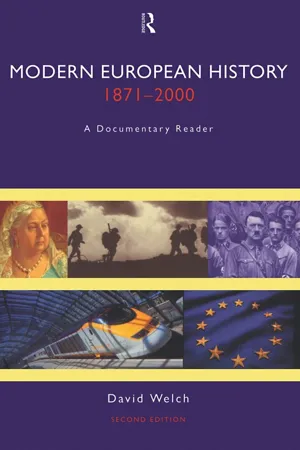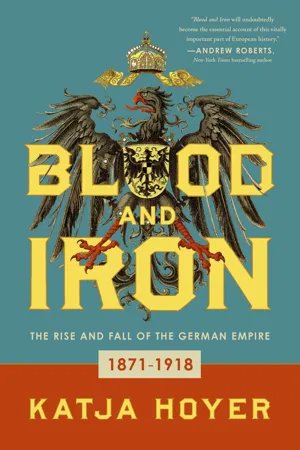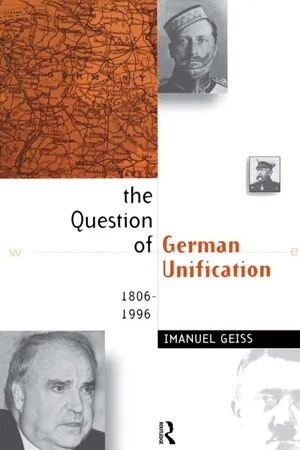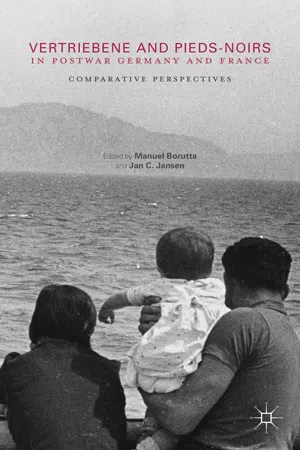History
Kaiserreich
Kaiserreich refers to the German Empire, which existed from the unification of Germany in 1871 until the end of World War I in 1918. During this time, the country was ruled by a Kaiser (emperor) and experienced significant industrial and military expansion. The Kaiserreich ultimately collapsed following Germany's defeat in World War I and the abdication of Kaiser Wilhelm II.
Written by Perlego with AI-assistance
Related key terms
8 Key excerpts on "Kaiserreich"
- eBook - ePub
Ethnic Minorities in 19th and 20th Century Germany
Jews, Gypsies, Poles, Turks and Others
- Panikos Panayi(Author)
- 2014(Publication Date)
- Routledge(Publisher)
CHAPTER 3The Kaiserreich , 1871–1918: Prejudice, Exploitation and Full EmancipationT he German nation state which came into existence in 1871 evolved from the economic, social and political transformations taking place in central Europe during the nineteenth century. In the period leading up to the First World War and the defeat which followed, the new political entity continued to experience many of the developments which characterized the decades leading to its formation. In addition, those in power attempted to mould the new state, although they often faced popular opposition from a series of movements from both the left and the right.The German nation state revealed itself as the most powerful on the European continent. The basis of this position lay in concrete geographic, economic and social facts. Although smaller in size than the massive area controlled by the Russian autocracy, as well as the crumbling Ottoman Empire, it rivalled or surpassed the other large European states of France, Great Britain, the declining Habsburg Empire, the largely irrelevant and distant Spain, and the equally new Italy. In addition, the first German nation state had the advantages of a growing population, which would surpass the size of many of its rivals by the outbreak of the First World War. Expanding at a yearly average of more than ten per cent, the number of people living within the German Empire grew from 40,995,000 in 1875 to 64,568,000 by 1910.1 In this year, Germany represented the second most populous state on the continent, way behind Russia’s 160.7 million inhabitants, but considerably ahead of the UK with 40.8 million residents.2In economic and social terms Germany has far more in common with Britain than Russia, as the process of industrialization, which had begun to take off earlier in the century, really reached fruition after 1871. Therefore, by the outbreak of the First World War, Germany had become a predominantly, but by no means exclusively, industrial state, which rivalled Britain, ‘the workshop of the world’ during the middle of the nineteenth century. Thus, the share of agriculture in the German GNP remained at between 35 and 40 per cent until the 1880s but fell back to stand at 25 per cent by the outbreak of the First World War, when industry’s share had increased to 45 per cent, while the commercial and service sector made up the remaining 30 per cent.3 The transformation took place in the heavy industries of coal, iron, steel, and railway building, which had also formed a major basis of British growth, as well as the new area of chemicals, where Germany reigned supreme because of the strength of her university science departments. By 1914 the new state produced more iron and coal than Britain.4 - eBook - ePub
- Mark Allinson(Author)
- 2014(Publication Date)
- Routledge(Publisher)
2 Imperial adventure 1871–1918 DOI: 10.4324/9780203784938-2Timeline18 January 1871 Kaiserreich proclaimed at Versailles 1878 Bismarck’s change of course 18 October 1878 Sozialistengesetz 15 June 1888 Accession of Wilhelm II 20 March 1890 Bismarck resigns 28 June 1914 The Austrian crown prince, Franz Ferdinand, is assassinated by Serb terrorists in Sarajevo 1 August 1914 The First World War begins 9 November 1918 Wilhelm II’s abdication announced; republic declared The late nineteenth and early twentieth centuries saw the European states expand their colonial empires to their greatest extent, with most of Africa, Asia and Australasia under European rule. At home, liberals secured the expansion of education and public health and, in some countries, greater democratisation. The rapid scientific and medical advances of this era enabled rising living standards for many, but the continuing industrial revolution condemned the growing urban working classes to impoverished conditions and fuelled the growth of socialist movements based on the teachings of Karl Marx and Friedrich Engels. The mutual suspicion of the principal European powers, and the new force of populist nationalism, encouraged an arms race and competition for political dominance in Europe. When the delicately poised system of mutually opposed diplomatic alliances collapsed in 1914, the First World War ensued, revealing the inherent weaknesses of the Turkish, Russian, German and Austrian empires, none of which survived this challenge.For many historians seeking to explain the origins and strength of Hitler’s national socialism, the age of Germany’s ‘second empire’ has seemed to hold many of the long-term causes. This chapter demonstrates how Germany retained the political hallmarks of the old monarchical structures, despite developing a strong industrial economy in which the working class rapidly expanded. These trends caused economic power to shift to the new capitalist classes, who had benefited from the industrial revolution but remained largely excluded from political power, which remained with the landed aristocracy. Germany’s failure to democratise at a time when liberalism was reforming many of the western European states has given rise to the theory of a German Sonderweg (‘special path’). It has been argued – but also disputed – that the dislocation caused by the concentration of political power in the hands of the Kaiser and his ministers on the one hand, and the growth of popular but powerless political movements on the other, prevented Germany from making the transition to a modern democracy. In studying the Kaiserreich, it is worth bearing these ideas in mind; they will be explored more fully in Chapter 4 - eBook - ePub
Blood and Iron
The Rise and Fall of the German Empire 1871–1918
- Katja Hoyer(Author)
- 2021(Publication Date)
- The History Press(Publisher)
4
WILHELM’S REICH 1890–1914
‘The kaiser is like a balloon: if you don’t keep fast hold of the string, you never know where he will be off to.’ Otto von BismarckPersonal Rule or Shadow Emperor?
‘Suprema lex regis voluntas ’ – ‘The will of the king is the highest law’ – wrote Wilhelm II in 1891 into the Golden Book of the City of Munich. It is one of many self-aggrandising statements that sum up the young Kaiser’s self-image as ruler perfectly. No longer would Germany be governed by an overbearing old bureaucrat like Bismarck, but a glorious new imperial era was to dawn that would inspire the German people to overcome their differences and find a national focal point in their Kaiser. This ‘policy of consolidation and conciliation’* would become the hallmark of Wilhelm’s early phase of kingship. However, the principles on which it relied were dangerous, not least among them a hostility towards the supposed enemies to German greatness: socialists, democrats and foreign rivals. The young Kaiser built up a glittering facade of imperial pomp in his palaces and castles that deliberately contrasted with the frugal interior of the chancellery in the Wilhelmstrasse. He thus tried to create an image of monarchical power that seemed outdated, even anachronistic to many. By the turn of the century, it would begin to unravel.The period from 1890 to 1914 has often been dubbed ‘Wilhelmine’ and for good reason. Just as Bismarck dominated the first phase of the German Empire from 1871 to 1890, Wilhelm put his own stamp on the period leading up to the First World War, at which point he was sidelined by the military establishment. It seems somewhat ironic that Bismarck had prided himself on protecting the German monarchy from the reduced status seen in other countries such as Britain, Italy or the Netherlands. There, constitutional ties had supposedly turned kings and queens into little more than ‘automatic signing machines’.* Bismarck nevertheless decided to put himself, as chancellor, at the heart of the first German constitution. But Wilhelm had other plans. He wanted no chancellor, parliament or ministers to mitigate his power. As Hans-Ulrich Wehler put it, ‘he tried to be both Chancellor and Emperor in one’.† - eBook - ePub
Modern European History 1871-2000
A Documentary Reader
- David Welch(Author)
- 2003(Publication Date)
- Routledge(Publisher)
1Imperial Germany, 1871–1918
The term ‘Germany’ had no real political significance at the beginning of the nineteenth century. The numerous states that made it up were loosely bound by their membership of the old Holy Roman Empire. The German Empire, or Second Reich, was created in 1871, and was founded on an unequal alliance between the national and liberal movements and the conservative Prussian state-leadership. The German Empire included Prussia, the kingdoms of Bavaria, Saxony and Württemberg, eighteen lesser states, three free cities and Alsace-Lorraine. It has been stated that the Prussian Chancellor, Otto von Bismarck, united Germany as the result of a series of successful military wars. However, closer examination reveals that the conditions for unification had been achieved before Bismarck came to power.During the nineteenth century there were three major steps towards unification: the creation of the German Confederation (1815); the formation of the German Customs Union (Zollverein) (1834); and the period of the decline of Austrian influence (1852–64). Brought about by naked militarism, the creation of the German Empire appeared to have fulfilled Bismarck’s prediction of 1862 that Prussia would unite Germany by ‘blood and iron’. In fact, the Empire had been established only after numerous compromises had been made and was immediately open to the criticism of being incomplete. Certainly when measured against the great aims of the 1848–9 Revolution—to create unity through freedom to build the state on new political, economic and social foundations—the founding of the Empire signified a defeat for middle-class liberalism. By and large, however, the majority of people warmly greeted the achievement of national unity. The story of imperial Germany after the euphoria of 1871 was the failure to adapt its institutions to the newly developing economic and social conditions.Left-wing liberal critics dismissed the Empire as an incomplete constitutional state. The liberals claimed that it should be governed on a wider parliamentary basis. A largely powerless parliament (Reichstag) was complimented by an upper house, the Federal Council (Bundesrat), which was made up of delegations from the separate states (not, therefore, representative of the German people as a whole). While the Reichstag possessed rights of veto, legislation was initiated in the Bundesrat, which could dissolve the Reichstag and declare war. The Bundesrat was effectively controlled by Prussia, which could block any measures deemed harmful to its own interests. - eBook - ePub
Crowns and colonies
European monarchies and overseas empires
- Robert Aldrich, Cindy McCreery(Authors)
- 2016(Publication Date)
- Manchester University Press(Publisher)
22The formal extent of the royal prerogative in the German colonies was quite clear.23 Articles 1 and 2 of the German Constitution made clear precisely to which German territories the Constitution pertained. The German colonies in Africa, the Pacific, China and, indeed, Alsace-Lorraine, were not among them.24 Strictly speaking, all constitutional provisions were therefore redundant in the colonies.25 As territories ‘not incorporated into the Reich’ which were ‘foreign lands in the sense of the imperial constitution and imperial law’,26 the colonies (or more correctly German dependencies, Schutzgebiete) were areas outside the guarantees of the Constitution and the concomitant regulatory role of German law. Although sometimes unsuccessfully contested,27 the operative legal position was that the German colonies were sites external to the constitutional Rechtsstaat and subject to the prerogative power of the Kaiser,28 whose authority in the colonies was ‘objectively unrestricted’.29 In addition, Paragraph 1 of the 1886 Protectorate Law made it clear that in South-West Africa, ‘sovereign power is exercised by the Kaiser in the name of the Reich’.30 - eBook - ePub
Blood and Iron
The Rise and Fall of the German Empire
- Katja Hoyer(Author)
- 2021(Publication Date)
- Pegasus Books(Publisher)
WILHELM’S REICH 1890–1914‘The kaiser is like a balloon: if you don’t keep fast hold of the string, you never know where he will be off to.’ Otto von BismarckPersonal Rule or Shadow Emperor?
‘Suprema lex regis voluntas’ – ‘The will of the king is the highest law’ – wrote Wilhelm II in 1891 into the Golden Book of the City of Munich. It is one of many self-aggrandising statements that sum up the young Kaiser’s self-image as ruler perfectly. No longer would Germany be governed by an overbearing old bureaucrat like Bismarck, but a glorious new imperial era was to dawn that would inspire the German people to overcome their differences and find a national focal point in their Kaiser. This ‘policy of consolidation and conciliation’I would become the hallmark of Wilhelm’s early phase of kingship. However, the principles on which it relied were dangerous, not least among them a hostility towards the supposed enemies to German greatness: socialists, democrats and foreign rivals. The young Kaiser built up a glittering facade of imperial pomp in his palaces and castles that deliberately contrasted with the frugal interior of the chancellery in the Wilhelmstrasse. He thus tried to create an image of monarchical power that seemed outdated, even anachronistic to many. By the turn of the century, it would begin to unravel.The period from 1890 to 1914 has often been dubbed ‘Wilhelmine’ and for good reason. Just as Bismarck dominated the first phase of the German Empire from 1871 to 1890, Wilhelm put his own stamp on the period leading up to the First World War, at which point he was sidelined by the military establishment. It seems somewhat ironic that Bismarck had prided himself on protecting the German monarchy from the reduced status seen in other countries such as Britain, Italy or the Netherlands. There, constitutional ties had supposedly turned kings and queens into little more than ‘automatic signing machines’.II Bismarck nevertheless decided to put himself, as chancellor, at the heart of the first German constitution. But Wilhelm had other plans. He wanted no chancellor, parliament or ministers to mitigate his power. As Hans-Ulrich Wehler put it, ‘he tried to be both Chancellor and Emperor in one’.III - eBook - ePub
The Question of German Unification
1806-1996
- Imanuel Geiss, University of Leeds Fred Bridgham(Authors)
- 2013(Publication Date)
- Routledge(Publisher)
3 Germany as a power centre Second and Third Reichs, 1871–1945The foundation of the Reich in 1871 seemed to have answered the German Question once and for all: in the new imperial Reich the Germans now had their nation-state, even though the Austrians had been excluded. Its borders had been drawn unambiguously. After three wars of unification, Germany had once again risen to become a power centre, though the annexation of Alsace-Lorraine was a potentially explosive, but self-inflicted handicap. With the apparent or formal disappearance of the German Question, the foundation of the Reich in 1871 and rapid transformation of Germany from a power vacuum to Europe’s central power centre opened up what some historians in the old Federal Republic, critical of German nationalism, from Fritz Fischer in 1961 onwards, called a new continuity.This continuity of German power politics under an imperial banner between 1871 and 1945 – whether Second or Third Reich – posed the question of how the Germans would use their new power. It is therefore imperative, for an understanding of the next phase of the German Question in the narrower sense of the term (1945–90), to explain first how the excessive power of the new Reich – in accordance with the dialectic of intention and inverse effect – was already preparing for Germany’s next division – via the ‘Struggle for Mastery in Europe’ (A.J.P. Taylor), which plunged the world into two world wars.THE SECOND GERMAN REICH, 1871–1918Internal structure of the KaiserreichThe question as to the new Germany’s internal structure had also been settled – it was to be a federal monarchy. While the Reich embodied an enormous concentration of power, it was not the unitary centralized state which the democratic left had always demanded, but which would have been at variance with political tradition since the demise of the Old Reich. Under a common roof, the German princes and free cities (Lübeck, Hamburg, Bremen) not only retained their internal autonomy, they were the formal representatives of the sovereignty of the German Reich, conceived as a federal state. In reality, however, Prussia – the largest state – was by far the most influential, a fact given institutional form in the personal union of the Prussian King and the German Kaiser, with the Prussian Ministerpräsident - eBook - ePub
Vertriebene and Pieds-Noirs in Postwar Germany and France
Comparative Perspectives
- Manuel Borutta, Jan C. Jansen, Manuel Borutta, Jan C. Jansen(Authors)
- 2016(Publication Date)
- Palgrave Macmillan(Publisher)
Part IFrom Empire to Nation-State: 1945 and 1962Passage contains an image 2
Legacies of Lebensraum: German Identity and Multi-EthnicityShelley BaranowskiSince the mid-1990s, historians of Germany have rediscovered ‘empire’ as a category of analysis that permits a deeper exploration of the multiple meanings of ‘Germany’ and its territorial fluctuations over time. They have looked especially closely at the maritime empire of the Second German Empire from 1884 to 1918, its impact on German identity, its earlier roots, and its relevance to subsequent periods in German history. Although research and debate on the imperialism of the Kaiserreich continues to thrive, German aspirations to a continental European empire inspired in part by the German migrations eastward from the Holy Roman Empire during the Middle Ages have received increased attention. As David Blackbourn argued recently, Mitteleuropa, or alternatively Osteuropa, was as important to Germans as India was to Great Britain and Algeria to France. Compared to the desire to colonize the ‘East’, Imperial Germany’s short-lived ‘blue water’ empire paled in significance.1 Not surprisingly, the need to assess the Nazi regime’s murderous Drang nach Osten, its continuities and ruptures with earlier imperial imaginings, contribute to this trend. Yet if the defeat of Nazism ended German expansionism, the ‘East’ left its traces in the forced migrations of ethnic Germans to what remained of the Reich. The destruction of the Nazi empire and the rediscovery of past precedents to cope with defeat shaped the most critical issue that the postwar Germanys had to confront as postcolonial societies: who indeed was ‘German’?Empire and its demiseAfter 1900, visions of a new German empire became central to the nationalist imagination. Radical nationalists, such as Heinrich Class and Alfred Hugenberg, aspired to a revitalized imperium as a bulwark against foreign intervention and as a home for Germans dispersed throughout east central and southeastern Europe. In their eyes, the Bismarckian unification in 1871 was just the beginning, a foundation for further expansion as far as Constantinople and the Black Sea. Not only would the enlarged empire embrace the Germans of continental Europe, it would also encourage the return of those who had emigrated to the Americas. Together, they would bring German Kultur to the barbarous Slavs.2
Index pages curate the most relevant extracts from our library of academic textbooks. They’ve been created using an in-house natural language model (NLM), each adding context and meaning to key research topics.

